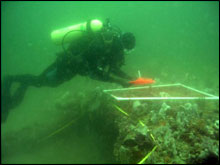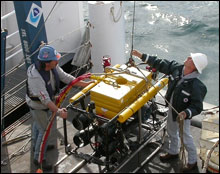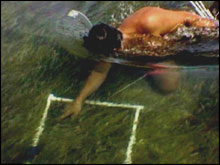NCCOS Assists in Characterizing Sanctuaries
NOAA’s National Centers for Coastal Ocean Science is partnering with the National Marine Sanctuary Program to provide scientific support for environmental characterization within the sanctuaries.
 |
| Statistically robust experimental design guides divers as they collect data to reveal spatial patterns of bottom types, organisms, and marine debris in Gray's Reef NMS. (Photo: NCCOS Center for Coastal Monitoring and Assessment)
|
|
|
NCCOS’s Center for Coastal Monitoring and Assessment (CCMA) Biogeography Team has assisted the Channel Islands NMS with boundary alternative assessments. The team also works in Gray’s Reef and Stellwagen Bank NMSs to complete benthic habitat mapping. In Monterey Bay, Cordell Bank and Gulf of the Farallones NMSs the team works to complete general biogeographic characterizations. CCMA’s COAST Team (Coastal Oceanographic Assessment, Status and Trends) works to understand the occurrence, amounts and sources of contaminants, including excessive nutrients that end up in sanctuary waters. Recent data strengthened and verified sanctuary managers’ appeals for improved water quality in Central California sanctuaries. The team also conducts satellite climatology to support characterization in several other sanctuaries. Read more about the exciting characterization work NCCOS’s Center for Coastal Monitoring and Assessment is conducting in sanctuary waters.
 |
| NCCOS scientists partner with OCNMS researchers to identify and assess critical deep-water coral habitat, a high-priority management issue for the sanctuary. Here the Navy's Phantom DHD2+2 ROV is deployed. (Photo: NCCOS Center for Coastal Environmental Health and Biomolecular Research)
|
|
|
NCCOS’s Center for Coastal Environmental Health and Biomolecular Research (CCEHBR) also conducts various characterization projects within several sanctuaries. For example, in Gray’s Reef NMS CCEHBR is assessing benthic macroinfaunal communities and chemical contaminant concentrations in sediments and biota. Visit their educational website, Sea Monsters in the Sand to learn more about benthic characterization at Gray’s Reef NMS. CCEHBR is also partnering with NMSP to conduct a first-ever comprehensive assessment of the ecological condition of near-coastal waters along the U.S. western continental shelf. Cruise surveys will be conducted in all five west coast sanctuaries. Finally, CCEHBR is also partnering with the Olympic Coast NMS to evaluate critical offshore habitats of the sanctuary and their susceptibility to fishing impacts at the sanctuary. Read more about the exciting characterization work NCCOS’s Center for Coastal Environmental Health and Biomolecular Research is conducting in sanctuary waters.
 |
| NCCOS scientists and FKNMS managers partner to protect critical seagrass habitat by evaluating recovery potential following vessel groundings that destroy seagrasses. (Photo: NCCOS Center for Coastal Fisheries and Habitat Research)
|
|
|
NCCOS’s Center for Coastal Fisheries and Habitat Research (CCFHR) supports characterization in the sanctuaries through a variety of projects. For example, CCFHR is working to evaluate the effectiveness of a marine reserve in the Florida Keys NMS. Read more about the success of the Tortugas Ecological Reserve. CCFHR also works to characterize the food web links in the newly designated Northwestern Hawaiian Islands Marine National Monument. Read more about this “Trophic Detective Story.”
|





